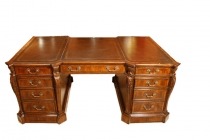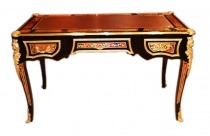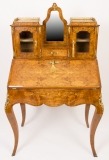Functional and Stylish Antique Desks
A guide to investing in a superb and substantial showpiece antique desk to enhance your home or office.
 In the digital age our offices and desks are everywhere and follow us around at all times on mobile phones, laptops, tablets and in the cloud.
In the digital age our offices and desks are everywhere and follow us around at all times on mobile phones, laptops, tablets and in the cloud.
But in simpler, less hurried times our predecessors went to their non-virtual office or study where the centrepiece was a functional and sometimes highly decorative antique desk. As well as a flat writing surface these desks offered drawers, storage compartments, pen holders, cubby holes, ink wells and also could feature intricate and detailed wood carving, beautiful craftsmanship, fabulous inlays, marquetry and veneers (using contrasting exotic woods such as ebony, rosewood, cheery and tulipwood), and sometimes even mirrored or stained glass ornamentation.
 Types of antique desks
Types of antique desks
Secretary desk – a very popular style with a drop down surface with the partition slanted when closed. Concealed behind the drop down are drawers, ink wells etc.
Flat Desk – these are generally larger and heavier than the secretary desk and comprise a flat working surface with drawers underneath, often with ornate carvings and decorative legs.
Partner Desk – a variation of the flat desk which is large enough for two people to work together; one at each side of the desk.
Roll Top – a highly sought after and collectible version of the flat desk with a rolling door which slides up and down to access the storage area hidden behind the roll top.
Lap Desks – a small box with a lift up lid for travelling (or even working in bed).
Captain’s Desks – highly decorated small desks from the cabin of a ship’s captain, with hidden compartments underneath a flat hinged top.
School Desks – small, often infant size, desks with a built in seat and simple storage beneath a hinged sloping top with a built in ink well.
 Drafting Tables – used by artists and draughtsmen with a sloping surface, no built in storage and simple wooden or metal legs.
Drafting Tables – used by artists and draughtsmen with a sloping surface, no built in storage and simple wooden or metal legs.
Periods of antique desks
Gothic – late 16th/ early 17th century – mainly oak with geometrical carvings and sometimes brightly coloured painted surfaces.
Baroque – mid 17th century – oak and walnut – flattened feet, arcade or geometric panels, rounded carvings and iron hinges and locks.
Rococo – late 17th/ early 18th century – walnut or mahogany – featuring intricate garden or marine motifs, and arched, asymmetrical legs.
Neo-classical – mid 18th/ early 19th century – mahogany – with claw and ball feet, ornamental carvings and Asian influenced designs.
Regency – mid 19th century – mahogany – strong Roman, Greek and Egyptian influences and characteristic metal decorations.
Victorian – late 19th century – mahogany – substantial pieces which were more mass produced and very often highly decorative with strong Gothic designs.
Art Nouveau – early 20th century – mahogany – abstract floral designs with strong curves and geometry.
Choosing your perfect antique desk
Like much antique furniture desks will have been subject to wear and tear and may well have been damaged and repaired with items such as locks or drawer pulls particularly likely to have been replaced.
Look for the maker’s mark to determine provenance, manufacturer and age. This mark may be on the desk itself or on some item of hardware such as a lock. Be wary of alterations which may affect value especially any replacement hardware, wood or stain. The feet of a desk can give a good indication of condition and collectability as rotten wood in feet is often replaced.
At Regent Antiques we carry an extensive range of really special antique desks and writing tables in beautiful condition. Our dedicated workshop can carry out careful and professional restoration where necessary to ensure that you are only buying the best – details of our current inventory is on our website or you can email or call for further details.

